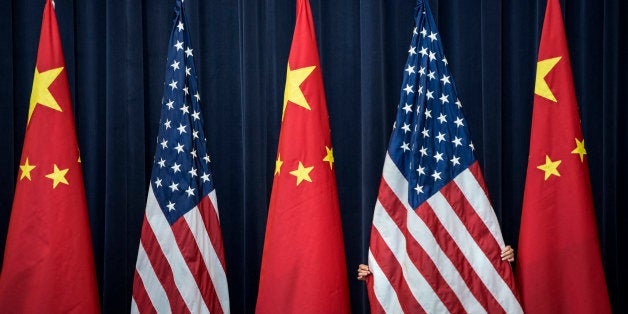
BEIJING -- In periods of the 19th and 20th centuries, the United Kingdom and United States maintained absolute dominance in a unipolar world, which was why they were called "British century" and "American century." Based on this, predictions of a so-called "Chinese century" must meet two preconditions -- a unipolar international configuration and absolute Chinese dominance.
It is a matter of guesswork whether or not these two preconditions will be met in the remaining 85 years of the 21st century. But the present-day world is heading toward a bipolar pattern featuring China and the United States.
Chinese Comprehensive National Strength Isn't Global
Even if China fulfills its second centennial goal of "building a prosperous and strong, democratic, civilized, harmonious socialist modern country" in 2049, the U.S. will not necessarily lose its superpower status thereby. International order is determined by two key factors: comparative strengths and strategic relationships of major powers. From the perspective of comprehensive national strength, the components of Chinese national strength are imbalanced.
The country's economy has found global impacts. Its political and cultural influences are limited to the West Pacific. Its military capabilities, the weakest link in terms of national power, have hardly gone beyond perimeter defense. For instance, from March 8th to 13th, fighter jets from Myanmar had repeatedly inflicted severe damage on civilian lives and properties within Chinese borders. It is far more difficult for Chinese comprehensive national strength to catch up with that of U.S.' than for its economy to do so. Not to mention its military. The U.S. upgrades its military capabilities through war, China through military drills. The difference here is like that between corporate executives and corporate governance scholars.
"The U.S. upgrades its military capabilities through war, China through military drills."
From the perspective of "hard power" and "soft power," China's global influences rest mainly on the economic elements of its hard power. China's soft power is not only far behind that of the U.S.', it may even lag behind that of Germany's. Germany is not just in an obviously dominant position in European affairs -- its impacts on non-economic, extra-regional affairs are evident. For example, during her latest visit to Japan, German Chancellor Angela Merkel warned Japanese Prime Minister Shinzo Abe to face up to history, revealing her country's advantageous position in soft power relative to Japan. Chinese leaders can't openly criticize their hosts on visits to European countries.
From the perspective of strategic relations of major powers, China only outdoes Russia and Japan, but remains behind the U.S., Britain, France and Germany. Russia is in strategic confrontation with the U.S., Britain, France, Germany and Japan. Japan stands against both China and Russia. Though China has strategic conflicts with both Japan and the U.S., it has better ties with Germany and France in comparison with Japan. German Chancellor Merkel paid seven visits to China in the last seven years, but only one to Japan.
Although the U.S. also has strategic conflicts with two major powers (China and Russia), its strategic relationships are of higher quality than those of China's. The U.S. adopts an alignment principle, and is in alliance with Britain, France, Germany and Japan; China follows a non-alignment policy, and is in cooperative partnerships with the U.S., Britain, France, Germany and Russia. The U.S. has about 60 allies, not including China; while China's 58 cooperative partnerships include the U.S.
Joseph Nye stated in his recent article "Only China Can Contain China," that China lack of high-quality strategic partners is an indication of the gap between Chinese and American comprehensive national strengths.
Political Might Is the Basis of Comprehensive National Strength
As Chinese economic growth slows down, some assume growth of Chinese comprehensive national strength has slowed down accordingly. However, the truth is that growth of China's comprehensive national strength has been accelerating since the Communist Party of China's 18th National Congress.
GDP growth in China showed a trend of slowdown from 2010 to 2014. But the rise in Chinese comprehensive national strength has been faster than in previous years since 2012. Speculative provocations like, "Chinese military buildup threatens U.S. forces" and "2015 will be Year One of a Chinese century" show that the outside world has felt the accelerating rise in China's comprehensive national strength.
"Comprehensive national strength = political might × (military might + economic might + cultural might)."
Comprehensive national strength = political might × (military might + economic might + cultural might). The equation can explain why comprehensive national strength can continue growing rapidly while economic growth slows down. Anti-corruption policies and proactive foreign policies have enhanced political might from the inside and outside. Politics is operational might, and can thus yield twofold outcomes with half the effort. Accelerating upgrades in national defense over the past three years is another reason for the rapid increase in comprehensive national strength.
The scale of the Chinese economy has surpassed 60 percent of that of the U.S'. Whether it can sustain high growth rests ultimately on if it adheres to the political trend of liberalizing its economy or "opening up." India's opening up came more than a decade after that of China's. So did its acceleration in economic growth. The degree of India's openness is less than that of China's, and so is its growth rate.
Countries featuring long-term openness have healthier national strength than those in long-term isolation. Disintegration of the Soviet Union and "color revolutions" in the Middle East are typical examples. Since 1978, the political line of opening up has upgraded China's comprehensive national strength in multiple ways. It has improved citizens' sense of right and wrong, corporate competitiveness, government capabilities for innovation, and the CPC's capabilities for error correction, laying a solid foundation for national self-confidence. Opening up does not guarantee realization of Chinese national rejuvenation. But not opening up would have certainly prevented the country from achieving it.
Bipolarization Extending From East Asia to the Asia-Pacific
Prediction of a unipolar "Chinese century" is entirely contrary to the post Cold War forecast of multi-polarization. But under current conditions, a bipolar international configuration is more likely than a multipolar or unipolar one.
In the next decade, no other major country except China can possibly narrow the gap between itself and the U.S. in national strength. U.S. comprehensive national strength outshines and is growing faster than those of Russia, France, Germany, Japan and Brazil. The gaps tend to widen. India's comprehensive national strength is below one-eighth of the U.S.', and the gap between the two's absolute strengths also displays a tendency of widening.
China ranks second worldwide in comprehensive national strength, and it can ensure a widening gap with those countries as long as it can maintain an equal speed of growth. It is very likely that China will grow faster. That both the U.S. and China are seeing widening gaps with other countries in national strength means it is possible that a bipolar power structure is in the making.
The trend of changes in strategic relations among major powers are more complicated than changes in relative strengths. Signs of bipolarization in strategic relations among major powers have become evident since China and Russia came into confrontation with western powers on the Syrian crisis in 2011.
The Sino-Japanese dispute over the Diaoyu Islands in 2012 resulted in the strategic conflict featuring China and Russia against the U.S. and Japan. In 2013, the Ukraine crisis enhanced Sino-Russian strategic cooperation, at the same time consolidated U.S.-European strategic cooperation.
Bipolarization is obvious now in East Asia. In security, it is a pattern of China-Russia versus U.S.-Japan; in trade, the U.S. and Japan advocate the TPP, China supports the Regional Comprehensive Economic Partnership; the China-Russia led BRICS bank doesn't include the U.S. and Japan, while the U.S. and Japan refuses to take part in the China-initiated Asian Infrastructure Development Bank, the U.S. had even tried to persuade Australia, the Republic of Korea and others into not participating.
As the bipolar pattern emerges, small and medium-sized countries in East Asia have displayed side-taking tendencies in their security strategies. Mongolia can only rely on China and Russia; Cambodia, the Laos, Malaysia, Thailand are approaching China; Myanmar and North Korea are distancing themselves from China, but are yet to come close to the U.S.; the Philippines, Singapore, the ROK and Vietnam rely on the U.S. Indonesia and Brunei are sitting on the fence, ready to go with the stream. East Asia's bipolar pattern may extend to the entire Asia-Pacific. Australia has chosen to cooperate with the U.S. and Japan strategically; Brazil has chosen to come into strategic cooperation with China.
"Bipolarization doesn't mean the world is seeing another Cold War."
Bipolarization doesn't mean the world is seeing another Cold War. Last century's Cold War was based on three necessary conditions: Mutual nuclear deterrence and ideological conflicts were the main contradictions, while proxy war was the main means of competition. Under the circumstance of continuous nuclear deterrence, the core contradictions in the Sino-U.S. bipolarization are those over international norms, instead of ideological ones, the means of competition are scientific and technological innovation as well as pursuit of friendly ties.
The Sino-U.S. bipolarization will promote changes in international order. The center of gravity of the world will shift from Europe to East Asia. U.S. global dominance will gradually weaken and eurocentric standards in international norms will increasingly give way to pluralist standards. The decline of global organizations and the rise of regional ones will take place simultaneously. What a bipolar international configuration to build will become a practical issue in international politics.

